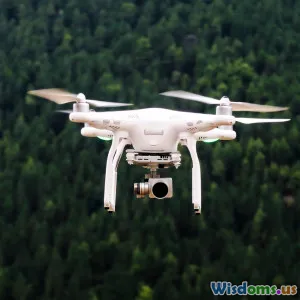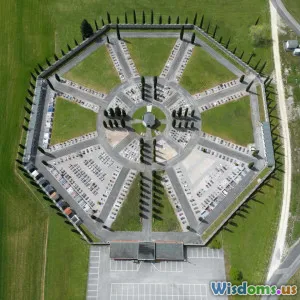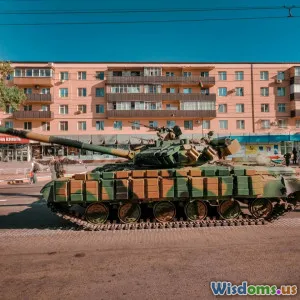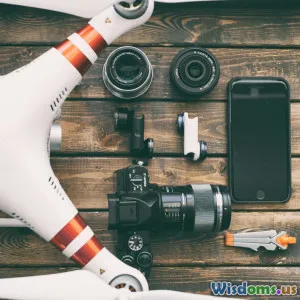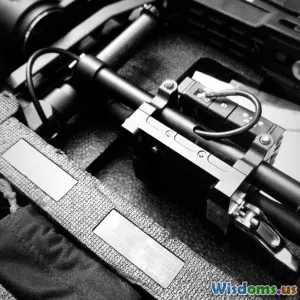
How Autonomous Tanks Handle Hostile Terrain in Combat
15 min read Explore how autonomous tanks master hostile terrain using advanced sensors, AI, and real-world tactics to reshape modern warfare and military mobility. (0 Reviews)
How Autonomous Tanks Handle Hostile Terrain in Combat
Introduction: Worlds Apart, Yet Driven to Conquer
In deserts riddled with jagged rocks and forests thick with mud, classic main battle tanks lumber forward under human command—often slowed or stopped by threatening landscapes. Now, imagine those hulking machines guided by digital minds, conquering places previously considered impassable, unafraid of landmines or snipers lurking around every corner. This is rapidly becoming reality: autonomous tanks are not just a promise, but a present that’s reshaping military might.
But what exactly grants these futuristic war machines the power to tackle the world’s most hostile terrains—whether it’s icy ridges, sun-blasted badlands, or even bomb-cratered urban sprawl—without a single soldier inside? To understand this technological leap, let's step inside the AI-driven heart and electronic nerve center of the autonomous tank.
The Rise of the Autonomous Tank: A New Age in Mobility and Warfare
For as long as armies have fielded armored vehicles, the landscape has been both ally and adversary. From muddy World War I trenches that bogged down early tanks to Afghanistan’s mountain passes that tested modern armor, mobility has been as important as firepower.
Yet, the 21st century has ushered in a seismic transformation: robotic autonomy. The United States, Russia, China, Israel, and several NATO nations are now racing to develop tanks and armored vehicles capable of navigating—and fighting—without direct human control.
Technological Drivers
Autonomous tanks hinge on three intersecting technologies:
- Sensor Arrays: High-resolution LIDAR, RADAR, thermal, optical, and ultrasonic sensors paint a live, 3D map of the world around the tank, 24/7.
- AI and Machine Learning: These complex algorithms interpret sensor data, recognize obstacles or threats, and make navigation decisions in milliseconds.
- Robust Actuation and Redundancy: Tanks can steer, accelerate, brake, and maneuver precisely—even in rough, unpredictable environments—thanks to advanced electric and hydraulic systems controlled by their electronic “brain.”
According to a 2022 U.S. Army Robotics Modernization Strategy report, integrating such capabilities is in active trials, with early field deployments already contributing to operational planning.
Navigating Hostile Terrain: The Core Challenges
A Test Unlike Any Other
Hostile terrain in combat isn't merely rocky or muddy; it’s dynamic, unpredictable, and deliberately dangerous. Obstacles might be naturally occurring (steep gullies, bogs, sand dunes) or the result of human activity (mined roads, traps, debris, quickly changing urban settings). Commanders have long recognized that the true test of a tank isn’t top speed or armor thickness—it’s whether the vehicle can reach its objective at all.
Key questions for autonomy include:
- How do tanks sense and interpret dramatically variable ground conditions?
- What lets them distinguish a pile of brush from a disguised anti-tank mine?
- How do they adapt mid-mission as the tactical situation evolves?
Advanced Sensors: The Eyes and Ears of Machine Navigation
Successful navigation begins at the sensory level. Autonomous tanks bristle with a variety of sensors, each tailored to recognize a specific type of threat or terrain feature:
1. LIDAR and RADAR
- LIDAR (Light Detection and Ranging) sweeps the landscape with laser pulses, generating detailed 3D maps—identifying ledges, ditches, and obstructions.
- RADAR systems, functioning in all weather and darkness, spot large obstacles, vehicles, and even subtle changes in ground composition.
Example:
Israel’s Carmel armored vehicle program uses a fusion of LIDAR, RADAR, and traditional cameras to create “see-through” awareness, fusing ground and aerial views in real time.
2. Thermal and Infrared Imaging
- Thermal sensors penetrate darkness, dust, and camouflage to spot heat signatures—vital for flagging buried minefields or hidden vehicles.
3. Geophysical Probing Sensors
- Ground-penetrating radar or acoustic sensors detect voids, tunnels, or altered substrates indicative of buried threats, a vital supplement in mine-laden zones.
4. Contextual and Terrain Databases
- Tanks tap into preloaded 3D maps, regularly updated with satellite or drone data, matching on-the-ground conditions with known terrain risks.
Data Insight: According to a General Dynamics Land Systems field test in 2021, integrating high-resolution LIDAR with real-time UAV drone mapping allowed an autonomous demonstrator to detour around a previously unmapped marsh, saving hours and avoiding near-certain immobilization.
AI-Driven Decision Making: From Perception to Action
Data is just the beginning. What makes an autonomous tank truly formidable is its capacity to process terabytes of incoming info and decide, rapidly, how to move or fight.
1. Path Planning Recognition
AI networks, often employing deep reinforcement learning, constantly scan all possible routes, balancing factors like:
- Level of threat: Minefields or suspected ambush zones
- Mobility: Ground softness, angle of incline, and stability
- Speed and Stealth: When to move fast, when to "creep"
- Immediate Tactical Objectives: Whether to close in, retreat, or engage
Example: The U.S. Army’s RCV (Robotic Combat Vehicle) prototypes adjust routes on-the-fly; when imaging reveals soggy ground, planners note the AI steers for firmer, albeit longer, detours.
2. Real-Time Obstacle Interpretation
AI image recognition software, trained on millions of photos and sensor returns, determines:
- Is that bump a harmless log, or a tripwire?
- Are those tracks from friendly vehicles, or an enemy ambush force?
3. Dynamic Risk Assessment
If anti-tank drones appear overhead, the tank can autonomously increase speed or seek the shortest route into forest cover, using prior satellite-imagery knowledge and real-time sensor adjustment.
Supporting Data: According to Boston Dynamics and DARPA demonstration exercises, autonomy increased platform survival rates by 45% in mock-combat settings versus crewed “blind” navigation when suddenly confronted with pop-up hazards.
Mobility in Adverse Environments: How Tanks Adapt Physically
1. Adaptive Suspension and Traction Control
Modern tanks like the Russian T-14 Armata and U.S. OMFV demonstrator boast electronically controlled suspension systems. By reading real-time terrain feedback, these suspensions adjust stiffness, ground clearance, and track tension for maximum grip and reduced risk of throwing a track or getting stuck.
2. Automated Recovery Procedures
What if the vehicle does get stuck? Many autonomous tanks are now designed with routines to:
- Self-diagnose wheel or track fouling
- Engage tow lines to unmanned buddy vehicles
- Alert remote commanders for remote-control extraction
Case Study: In a 2023 test by Rheinmetall in Germany, an unmanned Lynx IFV (Infantry Fighting Vehicle) encountered deep mud. Its autonomy module reversed, shifted weight, and rocked itself free without operator input—a feat that would have taxed even the best human driver.
3. Polar, Urban and Undulating Terrain Specialization
- Desert: Sophisticated dust-resistant filters, sealed electronics, and high-temperature engines give endurance.
- Arctic: Tanks integrate heated fluid lines, insulated batteries, and adaptive fuel management to stave off freezing.
- Urban: High-maneuverability skid steering, collision-avoidance edge sensors, and close-quarter vision arrays (360-degree cameras) enable navigation in tight alleys and debris fields.
Learning from Disaster: Failures, Redesigns, and Field Experience
Not all experiments succeed. Early trials in Ukraine's 2018-19 low-tech robotic tank deployments revealed surprising drawbacks: too much automation without sophisticated sensing led vehicles to tumble into shell craters or get lost in smoke-obscured rubble.
Building in Redundancy
Leading manufacturers have since embraced:
- Hybrid control: Seamless human override via remote control if AI systems fail or are jammed.
- Triple-redundant GPS/INS (Inertial Navigation Systems) for location-finding, crucial in GPS-denied battlefields.
Non-Stop Updates
Software updates based on actual field failures are now standard—every mission, successful or not, adds to the AI’s ability to learn, adapt, and respond better the next time hostile terrain or a new trick surfaces.
Quote:
“There is no substitute for bleeding edge field learning—a tank’s AI today is only as smart as the quantity and quality of missions it’s learned from,” — Dr. Anna Karpinski, Robotics Lead, Rheinmetall AG.
Human-AI Partnership: When and Why Operators Step In
Despite astonishing advances, autonomy is not infallible, especially in truly ambiguous environments. Sophisticated ground combat robots incorporate several layers of human involvement:
- Supervised Autonomy: Tanks alert a human operator in ambiguous or hazardous situations (e.g., suspicious objects, seen-but-not-identified threats).
- Direct Teleoperation: In extreme or contested electronic warfare conditions, local operators take direct control using encrypted digital links, often from portable command posts or supporting vehicles.
Practical Insight: The Israeli Defense Forces’ “Magen” UGV program, operational since 2021, equipped robotic armored vehicles with dual-mode controls. During a live-fire demo, human controllers seamlessly directed vehicles through urban grids when AI lost GPS linkage but rapidly returned control to autonomy once the connection restored.
Modern Combat Scenarios: Real-World Deployments
1. Border Monitoring and Area Denial
South Korea’s DMZ, infamous for its rugged, mine-strewn landscape, now features remote-controlled and semi-autonomous tracked sentry vehicles patrolling no-go zones where humans dare not tread. Their ability to handle rough ground while remaining alert to threats keeps borders secure without constant personnel hazard.
2. Battlefield Resupply and Casualty Evacuation
During NATO exercises in Norway’s frozen hinterlands, unmanned tanks ferried supplies and evacuated casualties over treacherous ice, thanks to actively heated engine bays and a knowledge base stressing frozen-lake maneuvers.
3. Urban Combat
In mock assaults on “hostile city” test ranges in France, autonomous tanks coordinated with drones to fan out, target snipers, and clear rubble-choked streets. Rapid sensor fusion kept them moving despite sudden threats, paving the way for infantry follow-ons.
Overcoming the Next Obstacles: The Road Ahead
1. Electronic Warfare (EW) & Cyber Resilience
Hostile forces increasingly target the comms and AI systems of autonomous platforms. Designers focus on anti-jam protocols, “black box” local control when links go down, and routine cyber red-teaming to counter emerging digital threats.
2. Ethics and Rules of Engagement
Can an autonomous tank be trusted to distinguish a civilian from an enemy fighter in rubble-strewn streets? Militaries worldwide (U.S. Defense Innovation Board, NATO, and more) continually update doctrine and test human-in-the-loop safeguards to ensure compliance with laws of armed conflict.
3. Broadening Terrain Mastery
Next-generation platforms will:
- Integrate AI weather forecasting for preemptive maneuver choices
- Learn directly from live drone and satellite feeds
- Co-evolve with drone swarms for mutual assistance in complex terrain
Conclusion: Beyond Human Limits, With Human Prudence
Autonomous tanks represent a game-changing fusion of AI, robotics, and military ingenuity. They have already demonstrated an ability to traverse and fight across hostile terrains once deemed impractical or suicidal for human crews. Advanced sensors, adaptive hardware, and learning algorithms make the modern autonomous armored vehicle not just a tool, but a thinking partner on the battlefield.
Yet autonomy does not mean absence of human judgment. The best armies embrace a partnership between machine and operator—each learning from the other, adapting to the unpredictable, and turning tomorrow’s hostile ground into tomorrow’s battle advantage.
As these vehicles continue to roll forward—across deserts, through urban labyrinths, over snowbound wilderness—we can expect a revolution not just in technology, but in the very art and science of combat mobility.
Rate the Post
User Reviews
Popular Posts











